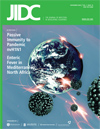Enteric Fever in Mediterranean North Africa
DOI:
https://doi.org/10.3855/jidc.606Keywords:
Typhoid, Paratyphoid, Salmonella, Egypt, Libya, Tunisia, Algeria, MoroccoAbstract
Typhoid fever is endemic in the Mediterranean North African countries (Morocco, Algeria, Tunisia, Libya, and Egypt) with an estimated incidence of 10-100 cases per 100,000 persons. Outbreaks caused by Salmonella enterica serovar Typhi are common and mainly due to the consumption of untreated or sewage-contaminated water. Salmonella enterica Paratyphi B is more commonly involved in nosocomial cases of enteric fever in North Africa than expected and leads to high mortality rates among infants with congenital anomalies. Prevalence among travellers returning from this region is low, with an estimate of less than one per 100,000. Although multidrug resistant strains of Salmonella Typhi and Paratyphi are prevalent in this region, the re-emergence of chloramphenicol- and ampicillin-susceptible strains has been observed. In order to better understand the epidemiology of enteric fever in the Mediterranean North African region, population-based studies are needed. These will assist the health authorities in the region in preventing and controlling this important disease.
Downloads
Published
How to Cite
Issue
Section
License
Authors who publish with this journal agree to the following terms:
- Authors retain copyright and grant the journal right of first publication with the work simultaneously licensed under a Creative Commons Attribution License that allows others to share the work with an acknowledgement of the work's authorship and initial publication in this journal.
- Authors are able to enter into separate, additional contractual arrangements for the non-exclusive distribution of the journal's published version of the work (e.g., post it to an institutional repository or publish it in a book), with an acknowledgement of its initial publication in this journal.
- Authors are permitted and encouraged to post their work online (e.g., in institutional repositories or on their website) prior to and during the submission process, as it can lead to productive exchanges, as well as earlier and greater citation of published work (See The Effect of Open Access).








